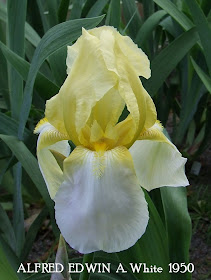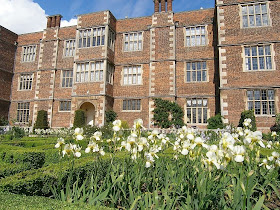
Black Forest bloomed at home late last week which is unusual as it is not renowned for re-blooming. It is the Iris that is acknowledged as the Progenitor of the great Schreiner Blacks
It has quite a nice scent and it ticks all the ID boxes apart from only reaching a stem height of 26"(66cm) yet Schreiner's have it listed as 33"(84cm) in their 1948 catalogue which featured BF on the cover. Whilst it is not uncommon for re-blooming irises to be shorter in the Autumn flowering there is some contention as to the height listed by Schreiner's and comments listed below could shine some light on this issue.
I have had BF growing at home for many years and have to say that this is the first time it has re-bloomed which probably has more to do with the long warm extended Autumn we are having rather than plant genetics.
From the publication "Iris as we Bloomed Them and as we Liked Them",
Second Edition 1946 Robert Schreiner, Schreiners Iris Garden St Paul, 7, MINNESOTA
"The Darks" page 17
'This is the first season that Black Forest has blossomed outside Minnesota. We introduced this iris as the deepest "black" iris in existence. The immediate approbation our iris brought forth was not only gratifying, it justified our feelings about this iris. It is not a tall or large iris'.
Schreiners Iris Lovers Catalog 1948
BLACK FOREST (Schreiners 1945) M 33"(84cm)
In Hybridising we have tried to develop an Iris "Black as Pitch" and Black Forest is the most striking development we have flowered. It is several registers darker and deeper in color than any named variety we grow or have seen. Fresh blooms of the other famous blacks are all definitely lighter toned when directly compared. In color it is a rich, silky, ebon-blue-black. The overall effect with the blue beard and solid haft is truly like the sable vested night. For so deep a color it is bright and gleaming, decidedly not a dull iris. The flowers are a medium size, the stem is not tall about 33 inches (84cm). Well substanced flowers, well carried, modified flare to nicely proportioned falls. See front cover (shown below) for Illustration $10.00

The measured height of the plant growing a home challenges Schreiner's Catalog description and the following information has made me comfortable that we have correctly ID this cultivar
'Cooleys' list Black Forest in their 'Irises for 1955' Catalog
"Black as pitch" says the introducer. A rich silky ebony-blue-black, the effect of which is intensified by a very solid haft and a blackish blue beard. Medium in height with flaring falls. HM AIS 1946 AM 1948. Of equal interest are the comments made just beneath this listing is the reference to 'Black Hills' an Iris introduced by Orville Fay in 1950 " Very tall ebony black Iris with lots of bloom, widely spaced on the stem. We have grown it to a height of 4 feet.(122cm) Just about the same depth as Black Forest, larger and twice the stature. (This in my opinion would indicate that the stem height of BF would be in the region of 24-26 inches or 61-66cm)
The Iris Year Book 1947 Published by the Iris Society (BIS)
A Second Iris Odyssey By G L Pilkington page 28
15th June Dr. Grave's planting at Concord New Hampshire
BLACK FOREST (Schreiner) ; of dark irises this is the deepest in colour and best in form, in my opinion. Flaring falls ; adequate branch but dwarf. Height 20 inches. It grows taller in some localities I believe .
The Tall Bearded Iris, Nicholas Moore
The first Schreiner black of note was BLACK FOREST, which achieved a greater blackness, perhaps through having a beard as black as the rest of the flower. It is a fine flower but not very large blue-black but short stemmed, but good for the front row of the border. Although so dark, it gleams and glints. Introduced in 1945, opinions are divided as to whether or not this is a real advance on SABLE.
Irises, Judith M. Berrisford Author, Pub. 1961 pg.28
BLACK FOREST (Schreiner,1945) 33" M-L
A glistening ebony-blue-black iris with a dark beard.Good form with neat, flaring falls and not over-large flowers.Scented. Unfortunately this iris is not reliable in flower, being apt to bloom only in alternative Years
The Iris Book , Molly Price Author 2nd Edition Pub.1973 pg.28
Border Bearded Irises
Standard tall bearded irises must by definition, be at least twenty eight inches tall. In the past the heights of some excellent seedlings were stretched a bit by the hybridizer in order to qualify them for registration as tall bearded. 'Black Forest a perfectly beautiful little twenty-four inch satiny blue-black variety now classed as a border iris was one of these. No one could blame the hybridizer for such a slight exaggeration, since there was no alternative classification.
Stevens Bros. Bastia Hill, Wanganui, 1957-1958 Catalogue
BLACK FOREST (Schreiner,USA)
This famous black iris is a rich silky ebony blue-black, very lovely with its dark blue beard and solid unmarked haft. For so deep a colour it is bright and gleaming. The flowers are medium size and the well branched stem reaches nearly three feet. Very free flowering, and a real monotone in the deepest colouring. Late 3/6
The World of Irises Chapter 6 pg.131, Bennett C Jones.
"Black Forest a 1944 Schreiner introduction was also relegated to the newly established border class and these two irises, (Pink Ruffles and Black Forest) though larger than what was later accepted as ideal for the class, became the criteria for the border plants"
'The World of Irises' page 70 Keith Keppel also writes about 'Black Forest'
"The Schreiner's had crossed The Black Douglas with a dark seedling from red breeding and this cross resulted in Ethiop Queen introduced the same year as Cook's Sable. Ethiop Queen crossed onto Dymia gave Black Forest, short of stature but with a depth of blackness previously unknown in the eupogons. It is interesting to note that a parent of Dymia is Harmony a satiny dark blue purple with a dark beard thought to be out of I.aphylla. Contemporary thinking is that I.aphylla carries a factor that intensifies color in its seedlings (Schreiner's 1958)
National Iris Gardens Beaverton Oregon 1949
BLACK FOREST (Schreiner 1945) M 33" HM AIS 1946 Dramatic new Iris. A smouldering purple under-glow add unexpected brilliance to this silky ebon blue black. A dark blue beard and solid haft intensify this monotone.
Fairmount Gardens Massachusetts 1950
BLACK FOREST (Schreiner 1945) M. A very deep richly colored iris of silky ebon blue black. The blue beard and solid haft add to the depth of color.The well substanced flowers are medium in size and well proportioned to the height of the stalk H.M AIS 1946 A.M AIS 1948 24"
Tell's Iris Gardens Iris Catalog 1951
BLACK FOREST (Schreiner 1945) (Dymia x Ethiop Queen) Not large or tall but very dark almost black A.M 1948
Lyon's Irisland Van Nuys, California 1953
BLACK FOREST (Schreiner 1945) Rich, silky ebony blue-black with a deep blue beard the same as the flower. Even the heart of the flower is as dark as deep night. The nicely formed fragrant blooms are of medium size on medium height stalks. Award of Merit AIS 1948 33"
M. Oliver Flower Farms and Milliken Gardens, Pomana, California 1958
BORDER BEARDED IRIS
Black Forest (Schreiner '45) L 26"
A Chic flower done in a gleaming blue black with matching beard. fragrant and floriferous. A.M '48
The Orpington Irises 1963
BLACK FOREST (Schreiner 1945)
Gleaming ebony blue black, even to the beard. Splendid form with neat flaring falls. Very free flowering. Scented. Height 2½ft
1949 AIS Checklist
BLACK FOREST TB-MLa-B1D Schreiner R R 1944 Fragrant (Dymia x Ethiop Queen), HM 1946, AM 1948.
The official height classification for Border Bearded Iris, 16 – 27.5" (40-70cm) tall, blooms with the TB’s
In the USA, Black Forest is available from Argyle Acres, Bluebird Haven Iris Garden,and Woodland Iris Garden.
A Big Hat Tip to Carlos Ayento of
Brighton Park Irises for the interaction of thoughts and discussion's concerning the above.
Photo Credit and Copyright Iris Hunter














